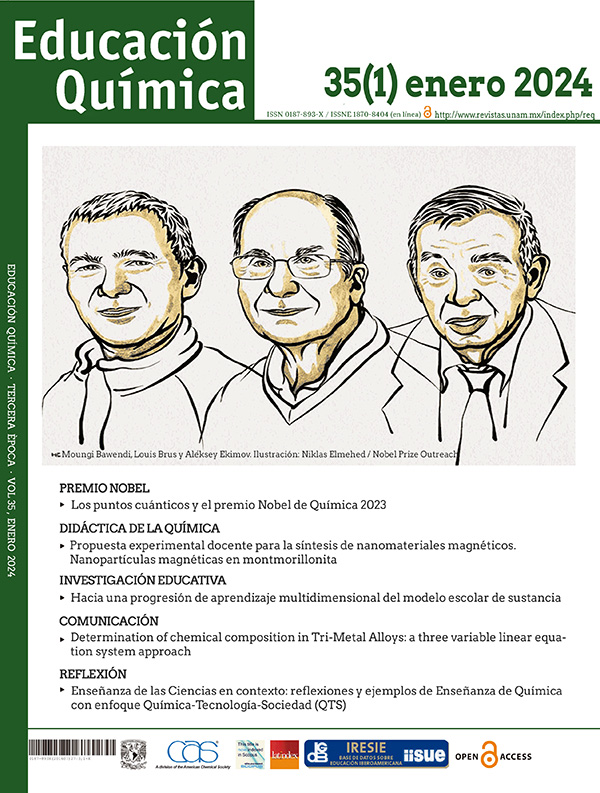Determination of chemical composition in Tri-Metal Alloys: a three variable linear equation system approach
Conteúdo do artigo principal
Resumo
To enhance the bridge between macroscopic and symbolic representations in chemistry, we crafted a laboratory module focusing on a three-equation system for chemical composition analysis. Students assess the composition of copper, tin, and aluminum alloys by measuring two properties: density and heat capacity. These non-destructive procedures fit within standard laboratory session durations. After gathering data, students tackle three linear equations linking element mass ratio to alloy composition, density, and heat capacity. By pooling data from various samples, the class achieves a comprehensive understanding. This method aligns with objectives for laboratory education, emphasizing scientific reasoning, practical skills, and subject mastery. Students’ results deviated by +/-10% from actual alloy compositions. The discussion of student-gathered data and results supports the feasibility of the laboratory experience for its implementation in introductory chemistry laboratories.
Detalhes do artigo
Citas en Dimensions Service
Referências
Bretz, S. L., Fay, M., Bruck, L. B., & Towns, M. H. (2013). What faculty interviews reveal about meaningful learning in the undergraduate chemistry laboratory. Journal of Chemical Education, 90(3), 281-288.
Chamizo, J. A. (2009). Filosofía de la química: I. Sobre el método y los modelos. Educación química, 20(1), 6-11.
Engineers Edge, LCC. Specific Heat Capacity of Metals. Visited on July 2023. https://www.engineersedge.com /materials/specific_heat_capacity_of_metals_13259.htm.
Galloway, K. R., & Bretz, S. L. (2015). Development of an assessment tool to measure students’ meaningful learning in the undergraduate chemistry laboratory. Journal of Chemical Education, 92(7), 1149-1158.
Hansen, S. J. R., Hu, B., Riedlova, D., Kelly, R. M., Akaygun, S., & Villalta-Cerdas, A. (2019). Critical consumption of chemistry visuals: eye tracking structured variation and visual feedback of redox and precipitation reactions. Chemistry Education Research and Practice, 20(4), 837-850.
Haynes, W. M. (1984). CRC handbook of chemistry and physics. CRC press.
Kelly, R., & Akaygun, S. (2019). Visualizations and representations in chemistry education. Chemistry Education Research and Practice, 20(4), 657-658.
Kelly, R. M., Akaygun, S., Hansen, S. J., & Villalta-Cerdas, A. (2017). The effect that comparing molecular animations of varying accuracy has on students’ submicroscopic explanations. Chemistry Education Research and Practice, 18(4), 582-600.
Kelly, R. M., Akaygun, S., Hansen, S. J., Villalta-Cerdas, A., & Adam, J. (2021). Examining learning of atomic level ideas about precipitation reactions with a resources framework. Chemistry Education Research and Practice, 22(4), 886-904.
Kolb, D. A. (2014). Experiential learning: Experience as the source of learning and development. 2nd edition. Pearson FT Press.
Millán, G. H. (2012). Enseñanza experimental.¿Cómo y para qué? Educación química, 23, 92-94. https://doi.org/10.1016/S0187-893X(17)30139-8.
Plotly Technologies Inc. (2015). Title: Collaborative data science Publisher: Plotly Technologies Inc. Place of publication: Montréal, QC.
Robinson, W. R. (2000). Learning about atoms, molecules, and chemical bonds: A case study of multiple-model use.
Taber, K. S. (2001). Building the structural concepts of chemistry: some considerations from educational research. Chemistry education research and practice, 2(2), 123-158.
Talanquer, V. (2009). Química:¿Quién eres, a dónde vas y cómo te alcanzamos? Educación química, 20, 220-226. https://doi.org/10.1016/S0187-893X(18)30056-9.
Talanquer, V. (2010). Construyendo puentes conceptuales entre las varias escalas y dimensiones de los modelos químicos. Educació química, 11-18. https://revistes.iec.cat/index.php/EduQ/article/view/61890.001
Touloukian, Y. S., & Buyco, E. H. (1971). Thermophysical properties of matter-the TPRC data series. Volume 4. Specific heat-metallic elements and alloys. Thermophysical and electronic properties information analysis center Lafayette in.
Villalta-Cerdas, A.; McCleary, C. (2019). Analysis of copper alloys as an introduction to data analysis and interpretation for General Chemistry courses. Educación Química, 30(2), 41-53. https://doi.org/10.22201/fq.18708404e.2019.2.67346.

Educación Química por Universidad Nacional Autónoma de México se distribuye bajo una Licencia Creative Commons Atribución-NoComercial-SinDerivar 4.0 Internacional.
Basada en una obra en http://www.revistas.unam.mx/index.php/req.




